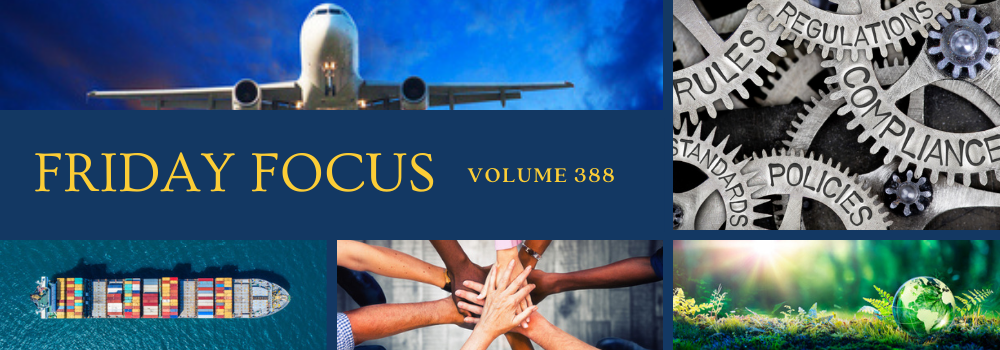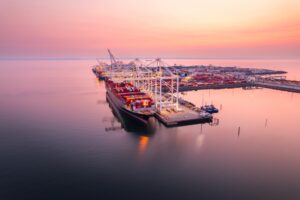Four Megatrends in Global Trade and Their Policy Implications
Following are excerpts from a piece published by the Asia Pacific Foundation of Canada.
Global trade is changing. It is buffeted by international and domestic pressures, from security tensions to climate burdens and technological innovation. Security competition is intensifying trade between ‘blocs’ and recalibrating long-standing trade dynamics. Conflicts in Europe and the Middle East are roiling supply chains already waylaid by the COVID-19 pandemic. Countries are using environmental measures to restructure production and trade. And technological shifts are accelerating trade facilitation while creating new challenges for countries that have not effectively regulated their digital economies.
Such challenges pose obligations, burdens, and expectations for countries like Canada that rely greatly on global trade for their economic growth and prosperity. Canada must prepare for an increasingly contested, complicated, and fractious global trade landscape that will only become more onerous to engage, negotiate, and leverage.
Four megatrends are dominating global trade:
First, U.S.-China security competition continues to cast a shadow over the trading system, affecting and rewiring regional economic partnerships. This seemingly persistent rivalry is compounded by muscular industrial policies from both countries and other powers (such as the European Union), further distorting trade patterns. Both ‘friend-shoring’ and ‘near-shoring’ could accelerate, despite constraints, with countries such as Mexico, South Korea, Thailand, and Vietnam benefiting disproportionately…
…Second, besides U.S.-China competition, other geopolitical fault lines (in Ukraine, the Middle East, and the South China Sea) will further stress world trade. Trade between regions is slowing as intra-regional trade grows. Southeast Asia, in particular, continues to benefit from this dynamic, at least for now. U.S. tariffs and export controls are pushing multinational firms to relocate manufacturing from China to Southeast Asia, boosting foreign direct investment and creating more jobs…
…Third, trade patterns, tensions, and preferences intersect, drive, and occasionally conflict with the unfolding energy transition as countries craft policies to mitigate climate change. Climate change is already affecting trade. Firms have to adopt low-carbon business models to become and/or remain globally competitive. Increasingly, sustainability will be commercially priced and included in the cost of doing business. New investment opportunities accompany climate mitigation. Some developed countries are strategically using trade-related environmental policies, littered with requirements to measure and verify the environmental footprint of imports…
…Fourth, technology is both enabling and constraining global trade. Although digital technologies are a key driver of trade, most countries have yet to effectively regulate their domestic and external effects. Digital trade measures have to be aligned across borders; this issue will become more important as countries pass laws on issues like data, AI, cybersecurity, and digital competition, which could affect digital trade.
Read the Full Dispatch Summary Here
08/21/2024 | Karthik Nachiappan | Asia Pacific Foundation of Canada
China’s Investigation Into EU Dairy: Careful What You Wish For

Night really does follow day! On Tuesday (20 August) the European Union announced its planned anti-subsidy tariffs on Chinese electric vehicles, a hefty 36.3%.
On Wednesday (21 August), China retaliated by opening an investigation into EU subsidies for cheese. Affected parties – the European Union, EU member states, dairy producers exporting to China – have twenty days to respond.
Clever move?
This move by China is either very clever or very stupid. Or possibly both. Let’s unpick it.
The first observation to make is that the EU will not have been taken by surprise by the opening of this cheese subsidy case. China invariably retaliates when its trading partners impose restrictions on its exports. In its announcement of the investigation China in fact refers to consultations having taken place with the Commission two weeks ago.
It is not impossible that it was even choreographed between China and the Commission, so that the Commission can demonstrate to EU member states that there will be a high price to pay if in November the EU imposes definitive duties on electric vehicles.
EU dairy producers in many member states pay the price for a trade spat in a wholly unrelated sector.
Why cheese? European wine and charcuterie producers must be heaving a sigh of relief as I write, as they were assuming they would yet again be the target of the obligatory retaliation.
China chose its target carefully. Cheese is a politically high-profile product in European eyes, it comes from a large range of member states – “there’s a cow in every member state” the saying goes. So, the pain will be distributed across the whole of the EU.
Yet at the same time exports to China – that famously lactose intolerant nation – are limited. In 2023 the EU sent to China just € 190 million worth of cheese. That figure pales in comparison with China’s € 20 billion of electric vehicle sales in Europe now to be hit with a up to 36.3% extra duty.
This means that the eventual imposition of anti-subsidy duties on Gouda and Pecorino Romano is unlikely to sway member states when they are called on in November to agree definitive duties on Chinese cars.
China’s announcement is above all political and symbolic, aimed at creating a bit of leverage over the EU but calibrated so as not to represent the opening salvo in a real trade war.
08/22/2024 | John Clarke | Borderlex
Does the EU’s Exit From the Energy Charter Treaty Foreshadow the Demise of ISDS?
Worldwide support for investor-state dispute settlement (ISDS) — a legal mechanism that permits foreign investors to pursue binding, third-party arbitration against a country over actions that harm their investments — has been under attack from Western democracies since at least 1998, when opposition by the U.S., Canada, and France led to the termination of negotiations toward a Multilateral Agreement on Investment (MAI). However, for more than two decades following this step, the EU and U.S. continued to negotiate bilateral investment treaties (BITs) and free trade agreements (FTAs) with ISDS provisions, including the 2015 Trans-Pacific Partnership (TPP) between the U.S. and 11 other nations and the 2016 Comprehensive Economic and Trade Agreement (CETA) between the EU and Canada.
More recently, indications that new ISDS agreements may be coming to an end have proliferated, at least with the EU and U.S., as discussed in this report. But the most recent and, perhaps, clearest sign of ISDS losing its appeal for the largest capital exporting jurisdictions is the EU’s unanimous decision in April 2024, effective in May 2024, to withdraw from the 1994 50-plus member European Union Energy Charter Treaty (ECT). The fact that the ECT had been renegotiated in 2022 because of concerns about its inconsistency with government responses to climate change were apparently not decisive. For the EU, the ECT is essentially abandoned. The future of ISDS, even with substantial reforms, such as those being discussed by the seemingly endless United Nations Conference on Trade and Development’s (UNCTAD) Working Group III, remains uncertain, although many developing countries, such as Mexico, still see it as a valuable stimulus for foreign investment despite reservations.
The U.S. had concluded multiple FTAs and a few BITs as late as 2007. More recent agreements were the TPP and the United States-Mexico-Canada Agreement (USMCA). The U.S., under former President Obama, was among the principal supporters of the TPP in 2015 — an agreement that incorporated then-traditional ISDS provisions. However, the U.S. withdrew under the Trump administration in January 2017, and the TPP became the Comprehensive and Progressive Agreement for Trans-Pacific Partnership (CPTPP). The 2018 USMCA saw a radical reduction in the scope of investor protection, with ISDS eliminated between the U.S. and Canada entirely and circumscribed between the U.S. and Mexico, with the full range of enforceable protections limited to a handful of government concession agreements…
That being said, the investment law bar and young lawyers who wish to join should take note: ISDS will be a feature of the international legal and investment world for decades to come. ISDS will still be of importance even if the U.S. avoids new agreements and withdraws from existing ones — the latter being difficult and, in my view, very unlikely, as discussed below — and if the EU and its members avoid new commitments. Why? Because worldwide, there are a total of about 2,222 BITs in force and 388 investment provisions in FTAs. Although a few International Centre for Settlement of Investment Disputes (ICSID) member countries, such as Bolivia, Ecuador, and Venezuela, have withdrawn from the ICSID Convention and terminated some of their BITs, the vast majority of ICSID members remain party.
08/20/2024 | David A. Gantz | Rice University’s Baker Institute for Public Policy
Why We Need an OPEC for Critical Mineral Producing Nations
On Thursday, September 12, WITA will host a panel event at the WTO Public Forum in Geneva, Switzerland to explore how the WTO can help foster a circular economy for critical minerals. Find more information here and below.
The most important UN panel you’ve never heard of will agree on a set of principles that could make or break the low carbon transition this week.
At stake is the future ownership of the world’s critical raw mineral supply chains that the renewable energy revolution will need to break free of our fossil fuel dependency.
The UN’s panel on critical energy transition minerals aims to inject justice, environmental standards and human rights into the sector’s supply chains. To do so, it must intervene in the international trade, investment and tax systems.
At present, the rich world wants to ensure that it – and it alone – controls critical mineral supply chains. The US Inflation Reduction Act dished out tax advantages to electric vehicle manufacturers which source, process or recycle in the US or its free trade agreement (FTA)-partners. The EU has also set a goal of processing 40% of the critical minerals that it consumes within its borders by 2030. The UK is following a similar path. But resource-rich countries aspire to process and transform more of their minerals so that they can see some of the economic rewards.
Of the ten countries which dominate the ownership of minerals via companies domiciled within their borders, eight are among the world’s richest Top 20.
While China is a major source of minerals like gallium, graphite, magnesium and tungsten, other countries including Brazil (niobium), Congo (cobalt), India (barite), Indonesia (nickel), Peru (arsenic), Russia (palladium) and South Africa (platinum and Manganese) are also significant players, and rarely talked about.
Critical minerals offer developing countries like these a “critical opportunity,” as the UN chief Antonio Guterres put it, when announcing the panel in April. “But only if they are managed properly,” he cautioned. “The race to net zero cannot trample over the poor.”
If that happens, the poor will understandably resist – and we will all suffer. To avoid this, we need a World Trade Organisation-level waiver of trade disputes in the climate realm preventing states from being challenged over policy tools crucial to sustainable industrialisation.
08/23/2024 | Ketakandriana Rafitoson & Nick Dearde | Publish What You Pay
WITA – We put the community in trade community.
Information about upcoming WITA and trade community events




